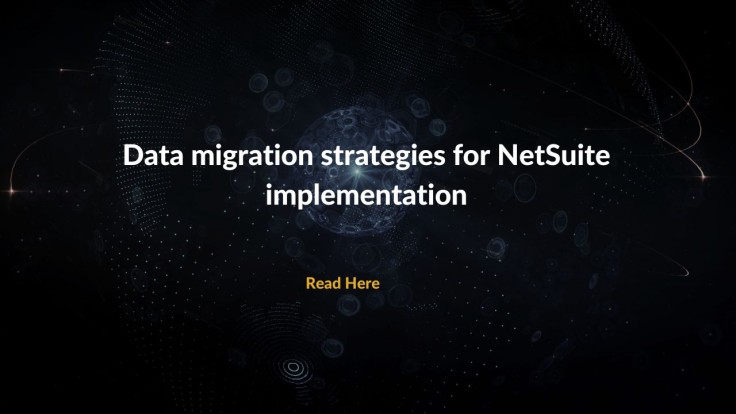
Data migration is a vital-but sometimes challenging step in NetSuite implementation. It's essential to plan carefully and do it right. Every ERP system's core is a shared database enabling users to rely on the same, consistent information set. When implementing ERP software like NetSuite, an organization must move data from older systems into this database.
Underestimating the time and effort required can delay the entire NetSuite implementation process. Additionally, the accuracy of the transferred data is pivotal because so many parts of the business- decision-making, customer satisfaction, supply chain, and partner relationships rely on the database.
This article thus explores data migration and some effective data migration strategies for NetSuite implementation.
NetSuite Implementation & Data Migration
NetSuite data migration transfers data from its sources to the ERP system's database. It often involves moving data from various systems, formats, and storage types into a single, standard structure.
Before adopting NetSuite ERP, some departments may use systems designed to support only their specific functions, such as standalone accounting or human resources applications. At the same time, other groups may rely on general-purpose tools such as spreadsheets. For a successful NetSuite partner data migration, businesses must take a systematic approach, which typically includes inspecting, extracting, cleansing, and transforming the data from each application before importing it into the database. By collaborating with a certified NetSuite partner, companies can ensure a smooth and efficient migration process, leveraging the expertise and support of experienced professionals to maximize the benefits of NetSuite's comprehensive ERP solution.
Data migration challenges and their solutions
While transferring data from legacy systems to NetSuite, businesses may face multiple challenges that can impact the efficiency and success of the migration.
1. Data mapping and transformation
Challenge: Migrating data from legacy systems to NetSuite requires accurate mapping and transformation to ensure compatibility and data integrity.
Solution:
Conduct a thorough analysis of the legacy system and NetSuite data structures to identify the mapping requirements.
Create a comprehensive data mapping document that outlines how each field in the legacy system corresponds to the fields in NetSuite.
Utilize data mapping tools or work with experienced consultants who can automate and streamline the mapping process.
Validate the mapped data to reflect the intended information in NetSuite accurately.
2. Data cleansing and quality assurance
Challenge: Legacy systems often contain data inconsistencies, duplicates, and inaccuracies that can impact the reliability and integrity of migrated data.
Solution:
Perform data profiling and analysis to identify data quality issues such as duplicates, missing values, and inconsistencies.
Develop data cleansing strategies and implement techniques such as deduplication, normalization, and validation to improve data quality.
Utilize data quality tools or work with experienced consultants to automate data cleansing processes and ensure data accuracy.
Conduct regular data quality checks and validation during and after the migration to maintain data integrity in NetSuite.
3. Data volume and complexity
Challenge: Managing and transferring large volumes of data while maintaining accuracy and performance can be a significant challenge during migration.
Solution:
Implement data extraction, transformation, and loading (ETL) processes that optimize the migration of large datasets.
Utilize parallel or batch processing techniques to distribute the workload and improve migration efficiency.
Employ data compression or archiving methods to reduce the overall data volume and improve migration speed.
Prioritize data based on business needs and migrate critical data first, followed by less critical or historical data.
4. Data relationships and dependencies
Challenge: Migrating data with complex relationships and dependencies between different data sets requires careful sequencing and validation.
Solution:
Identify and analyze the relationships and dependencies between data entities, such as customers, orders, products, and transactions.
Develop a migration strategy ensuring NetSuite data migration's correct sequencing to maintain data coherence and integrity.
Implement data validation and verification processes to ensure that migrated data accurately reflects the relationships and dependencies in NetSuite.
Conduct thorough testing to validate the consistency and accuracy of the migrated data across interconnected data sets.
5. Downtime and Business Continuity
Challenge: Minimizing downtime and ensuring business continuity during migration is crucial for uninterrupted operations.
Solution:
Plan the migration process meticulously, considering the least disruptive times for system downtime or limited data access.
Communicate the migration schedule and potential impact to all stakeholders, ensuring they are prepared for any temporary disruptions.
Implement parallel running systems or hybrid approaches, where legacy and NetSuite systems coexist temporarily, ensuring seamless continuity during migration.
Regularly communicate progress and provide updates to stakeholders to maintain transparency and manage expectations.
6. Data Validation and Testing
Challenge: Validating and testing migrated data's accuracy, completeness, and functionality is essential to ensure a successful migration.
Solution:
Conduct data reconciliation exercises to compare NetSuite's migrated data with the legacy system's source data. This helps identify any discrepancies or missing data during the migration process.
Perform data validation checks to ensure the migrated data meets predefined business rules, validation criteria, and data quality standards.
Test data consistency across various modules and functionalities in NetSuite, including customer management, inventory control, financials, and reporting.
Validate data relationships and dependencies by verifying that linked data, such as customer orders or transactions, are accurately migrated and maintain their associations.
Conclusion
Data migration is crucial to Netsuite partner implementation, enabling organizations to preserve historical records, maintain business continuity, and leverage data-driven decision-making. Organizations can achieve a seamless and successful Netsuite partner data migration process by considering key factors such as data assessment, mapping, validation, and utilizing appropriate tools and expertise. With accurate and complete data migrated into Netsuite partner, organizations can unlock the full potential of the ERP system and drive their business forward.









